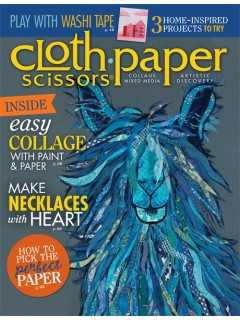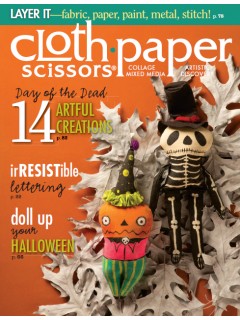"Winter is Coming" (c) Kit Lang 2014 background composed of pieced disperse dyed fabrics
After
having a conversation with someone on FB yesterday about disperse dye, I was
inspired to do a post about HOW to disperse dye. Disperse dye is also known as
"transperse dyeing" and "transfer paint" dyeing.
Although
when I first tried this process, I bought the ready-made bottles of transperse
paint, the next time I tried mixing my own colours, which was a raging success.
You can choose how much, mix your own colours, and more importantly, I got much
better results with the home-made dyes than the ready-made.
So
here is my method:
Mixing
the colours:
I used IDye for my disperse
dyes (the link is for a Canadian store but I believe you can also get it
at Dharma Trading. However, any powdered dye that is meant for polyester fabric
will do.
I mix
the powders to the following method:
a) 1
tsp for pale
b) 2
tsps for medium
c) 4
tsps for dark
d) 8
tsps for black
and
then stir the dye into a 1/2 cup of boiling water and two drops of
synthrapol for an opaque result. If you want a thinner, more watercolour
effect, mix with 1 cup of boiling water.
When
the mixture(s) are cool, paint your papers (more below), and let them dry.
Painting
the Paper
There's
no secret or particular method to this process. The most important thing
for me was the paper itself - I had the best results BY FAR using paper
from a student sketchbook rather than bond (photocopy paper).
I
found the heating process bound the colour to the bond paper (that's what
photocopy paper is for, after all!) whereas the colour just sat on top of
sketchbook paper. However, you don't want to use a really, really good quality
sketchbook paper as the colour will then sink into the texture of the paper
rather than sit on top.
Once
you have the right paper, make sure you have a place set up where your can lay
your papers flat to dry, as well as drip dry - one of my
favourite papers was hung to dry and as a result has drips and globs of dye on
it that translate really well when transferring.
As for
the painting itself - the sky is the limit. I painted papers with one
colour, multiple colours, in patterns, in solids, I did solid undercoats with
finger painted swoops and curves over top of the dried solid backgrounds, I painted
grid patterns, combed the fluid on the paper, splattered them,
"dropped" dye on the papers, smooshed the colour with my hands - or
combinations thereof. Do whatever you want, let them dry and see what
happens!
Try to
keep notes as you're making your papers of what you've put on them, and once
they're dry, write it on the back. Once you've done a press and see the result,
write again what the colours actually
turned out to be. That way you can re-create them, and also, when you want to
use the paper again, you'll know what your result should be. (Although it will
get a bit paler with each session.)
Fabric
choice
If you
want "glowing" colours, then the higher the amount of 'man made'
material in the fabric, the better result you'll have. I had the very
best result with 100 polyester silk which gives a really lovely glow to the
fabric. I also tried a sheer polyester tulle with a very dark value paper which
produced a really lovely see through print.
But as
I don't like the "shiny" look of the fabric (in most applications, the
sheen distracts from the overall piece), I use predominantly cotton, rayon, and
polycotton mix fabric.
Transferring
the colour
Start
by using a heavily padded surface on your table, and then put a sheet of craft
paper over it (otherwise the colour will transfer to your ironing
"pad".)
Lay
the fabric on your pad right side up,
and put the painted paper(s) face down on the cloth, and then put another, bigger sheet of craft paper on top of it all
to keep the iron clean.
VERY IMPORTANT!
While
you're working, keep the iron moving, and keep the iron HOT HOT HOT(no matter
what the fabric requirements are - you have two layers of paper between the
fabric and the iron to protect it) and press down as hard as you can. Just
really lean on that sucker! J
A note
about the iron: I have used a standard iron with steam holes in it. If you are
using such an iron, make sure that there is no water in the iron, and never let
the iron sit still. If you do so, there will be a pattern from the steam holes
on your finished product. I have purpose bought an iron that has no steam holes
whatsoever – I looked long and hard through various charity shops and second
hand stores to find one, but I finally scored!
The
longer you press and/or the more pressure you apply when you press, and the
higher the heat, the more brilliant your result is.
Disperse dyed large piece of fabric - also made with torn up bits of disperse dyed papers. This eventually because a throw cushion.
Further
Advice
Try
different things with your papers - using resists, cutting out shapes from your
dried papers or tearing the papers into rough pieces and laying them out on
your fabric as I did for the piece above. The key is to keep that iron moving
and to do it as long as you can.
Don't
worry if your first pieces are crap - my first ten were!! :) It takes a
bit of time to get used to the process, and if you're using the wrong kind of
fabric, you'll never get a good result. There are definitely fabrics this
process likes, and some it really DOESN'T like. Lol
You
will naturally get a few disappointing pieces as you begin this process, but if
you continue to do so, try a different fabric.
I
have, with success, overdyed a disappointing procion MX dyed cloth with
disperse dyes and gotten really beautiful results, so really, the sky is the
limit with this process.
When you are finished
making your fabrics, put the dried papers away for further use in the future.
Although conventional
advice is that you only get one or two good passes out of the papers, there are
some papers that I have been using for years! It depends on how thickly you
applied your "paint" and how much detail there is to it. One paper in
particular which I had painted with a solid colour, let it dry, painted over it
in sections with other colours, let it dry, and then painted again with a drip
dry method has yielded nearly 20 sessions although I finally had to throw it
out last year, after first creating five years ago.
And
that's it!
One great advantage of this process is that it doesn't take
up a lot of space. You can make as much or as little dyed fabric as you like,
you don't have to hang it up to dry, and the little packets of dye are just
that – little packets. You can pop them into a ziplock bag and stick them in a
file folder with your finished papers, until the next time you want to dye!
I hope you try this process and if you do, link us to your
results in the comments!
Kit










Excellent! I may have to try this.
ReplyDelete